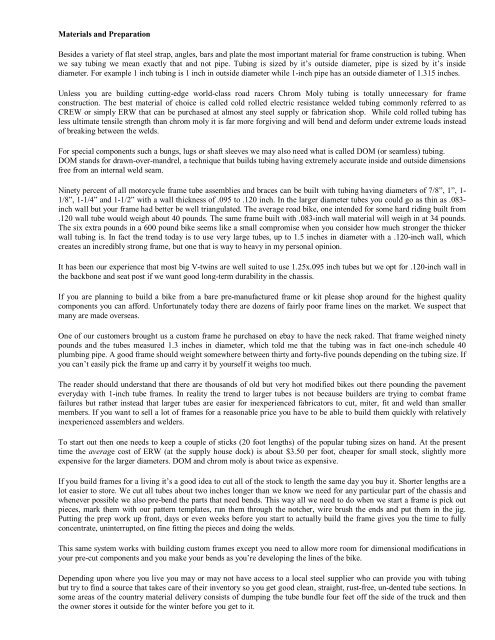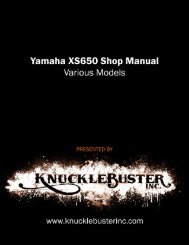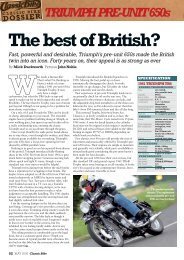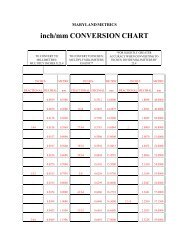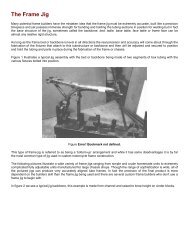Old School Chopper Frame Fabrication - Knucklebuster
Old School Chopper Frame Fabrication - Knucklebuster
Old School Chopper Frame Fabrication - Knucklebuster
Create successful ePaper yourself
Turn your PDF publications into a flip-book with our unique Google optimized e-Paper software.
Materials and Preparation<br />
Besides a variety of flat steel strap, angles, bars and plate the most important material for frame construction is tubing. When<br />
we say tubing we mean exactly that and not pipe. Tubing is sized by it’s outside diameter, pipe is sized by it’s inside<br />
diameter. For example 1 inch tubing is 1 inch in outside diameter while 1-inch pipe has an outside diameter of 1.315 inches.<br />
Unless you are building cutting-edge world-class road racers Chrom Moly tubing is totally unnecessary for frame<br />
construction. The best material of choice is called cold rolled electric resistance welded tubing commonly referred to as<br />
CREW or simply ERW that can be purchased at almost any steel supply or fabrication shop. While cold rolled tubing has<br />
less ultimate tensile strength than chrom moly it is far more forgiving and will bend and deform under extreme loads instead<br />
of breaking between the welds.<br />
For special components such a bungs, lugs or shaft sleeves we may also need what is called DOM (or seamless) tubing.<br />
DOM stands for drawn-over-mandrel, a technique that builds tubing having extremely accurate inside and outside dimensions<br />
free from an internal weld seam.<br />
Ninety percent of all motorcycle frame tube assemblies and braces can be built with tubing having diameters of 7/8”, 1”, 1-<br />
1/8”, 1-1/4” and 1-1/2” with a wall thickness of .095 to .120 inch. In the larger diameter tubes you could go as thin as .083inch<br />
wall but your frame had better be well triangulated. The average road bike, one intended for some hard riding built from<br />
.120 wall tube would weigh about 40 pounds. The same frame built with .083-inch wall material will weigh in at 34 pounds.<br />
The six extra pounds in a 600 pound bike seems like a small compromise when you consider how much stronger the thicker<br />
wall tubing is. In fact the trend today is to use very large tubes, up to 1.5 inches in diameter with a .120-inch wall, which<br />
creates an incredibly strong frame, but one that is way to heavy in my personal opinion.<br />
It has been our experience that most big V-twins are well suited to use 1.25x.095 inch tubes but we opt for .120-inch wall in<br />
the backbone and seat post if we want good long-term durability in the chassis.<br />
If you are planning to build a bike from a bare pre-manufactured frame or kit please shop around for the highest quality<br />
components you can afford. Unfortunately today there are dozens of fairly poor frame lines on the market. We suspect that<br />
many are made overseas.<br />
One of our customers brought us a custom frame he purchased on ebay to have the neck raked. That frame weighed ninety<br />
pounds and the tubes measured 1.3 inches in diameter, which told me that the tubing was in fact one-inch schedule 40<br />
plumbing pipe. A good frame should weight somewhere between thirty and forty-five pounds depending on the tubing size. If<br />
you can’t easily pick the frame up and carry it by yourself it weighs too much.<br />
The reader should understand that there are thousands of old but very hot modified bikes out there pounding the pavement<br />
everyday with 1-inch tube frames. In reality the trend to larger tubes is not because builders are trying to combat frame<br />
failures but rather instead that larger tubes are easier for inexperienced fabricators to cut, miter, fit and weld than smaller<br />
members. If you want to sell a lot of frames for a reasonable price you have to be able to build them quickly with relatively<br />
inexperienced assemblers and welders.<br />
To start out then one needs to keep a couple of sticks (20 foot lengths) of the popular tubing sizes on hand. At the present<br />
time the average cost of ERW (at the supply house dock) is about $3.50 per foot, cheaper for small stock, slightly more<br />
expensive for the larger diameters. DOM and chrom moly is about twice as expensive.<br />
If you build frames for a living it’s a good idea to cut all of the stock to length the same day you buy it. Shorter lengths are a<br />
lot easier to store. We cut all tubes about two inches longer than we know we need for any particular part of the chassis and<br />
whenever possible we also pre-bend the parts that need bends. This way all we need to do when we start a frame is pick out<br />
pieces, mark them with our pattern templates, run them through the notcher, wire brush the ends and put them in the jig.<br />
Putting the prep work up front, days or even weeks before you start to actually build the frame gives you the time to fully<br />
concentrate, uninterrupted, on fine fitting the pieces and doing the welds.<br />
This same system works with building custom frames except you need to allow more room for dimensional modifications in<br />
your pre-cut components and you make your bends as you’re developing the lines of the bike.<br />
Depending upon where you live you may or may not have access to a local steel supplier who can provide you with tubing<br />
but try to find a source that takes care of their inventory so you get good clean, straight, rust-free, un-dented tube sections. In<br />
some areas of the country material delivery consists of dumping the tube bundle four feet off the side of the truck and then<br />
the owner stores it outside for the winter before you get to it.


